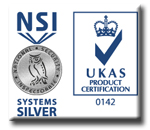Guidance on Intruder Alarm Grading
The security and insurance industries use the term ‘Risk Assessment‘ for the new European Systems Standard EN 50131-1 (or the British equivalent PD6662), which lays down a structured Risk Assessment procedure for designers of intruder alarm systems.The security and insurance industries use the term ‘Risk Assessment’ for the new European Systems Standard EN 50131-1 (or the British equivalent PD6662), which lays down a structured Risk Assessment procedure for designers of intruder alarm systems.
A properly completed Risk Assessment will lead to an appropriately designed and graded system. When designing a confirmable alarm system, insurers expect alarm installers to take into account the need to detect intruders before they reach the target, as well as the need to have confirmation of detection.
One of the most significant issues within the new EN Standard is evaluating the risk associated with the premises and determining a grade of system which will be directly proportional to the insurance value of the property and its contents. Once the grade of a property has been determined, it will define the extent of its alarm system, the type of remote signaling/alarm monitoring used and the system’s tamper security (ie. the method used to protect an intruder alarm system against deliberate interference).
A properly completed Risk Assessment will lead to an appropriately designed and graded system. When designing a confirmable alarm system, insurers expect alarm installers to take into account the need to detect intruders before they reach the target, as well as the need to have confirmation of detection.
One of the most significant issues within the new EN Standard is evaluating the risk associated with the premises and determining a grade of system which will be directly proportional to the insurance value of the property and its contents. Once the grade of a property has been determined, it will define the extent of its alarm system, the type of remote signaling/alarm monitoring used and the system’s tamper security (ie. the method used to protect an intruder alarm system against deliberate interference).
Basic Guide to Intruder Alarm Grades
| Alarm Grade | Level of Risk | Type of Premises | Insurance Approval | Notification Options |
|---|---|---|---|---|
| 1 | Low | DIY Type Installation | NO | NO |
| 2 | Low to Medium | Residential & Commercial | YES | YES |
| 3 | Medium to High | Commercial | YES | YES |
| 4 | Very High | Banks etc | YES | YES |
What are the Grades?
Grade 1 is for a low risk of theft. It applies to a property which is not likely to attract burglars. In the application guide (DC CLC/TS 50131-7), it assumes that a thief is likely to be opportunistic rather than planning a theft and will simply break open a door.
Grade 2 is for a higher risk of theft. Such a property is likely to have something of interest to an experienced thief who is likely to have some knowledge of how alarm systems work and possibly carry some tools to help him overcome a simple alarm system. The thief is likely to check the building for easy access through doors, windows and other openings.
Grade 3 is for a property which is a reasonably substantial risk, one which, might well contain objects of high value so there is a good reason to assume it may be broken into. An intruder is likely to be knowledgeable about intruder alarm systems and have the tools and equipment to overcome the system. The thief is likely to get in by penetrating doors, windows or other openings.
Grade 4 is for highest-risk properties. Such properties are likely to be targeted by a gang of thieves who will probably have planned the burglary in advance. They will know how to tamper with the intruder alarm system to prevent detection and can be expected to gain access by penetration of floors, walls and ceilings.
Choosing the Right Intruder Alarm Company
Selecting the type of alarm for your business is one thing. If you want it to be effective and meet the requirements set out by the police and your insurer, it’s important to have it installed and maintained in accordance with the required standards by a professional company such as those approved by NSI.
Here are some key questions to ask the company you are considering to install your system. Are they…
- thoroughly security vetted?
- rigorously inspected twice a year to ensure they are maintaining standards in both the quality of installation and how they are run as a business?
properly insured? - operating a 24 hour call out service (and do they respond within 4 hours)?
- able to complete a thorough security survey of your property?
- installing reliable, up to date equipment?
- going to issue you with a Certificate of Compliance for your system?
- meeting the relevant British and European Standards?
- Comparable to ADT Verisure systems
NSI approved companies can answer ‘yes’ to all these questions. NSI provides the toughest inspection services to ensure that all its approved companies continually meet the highest standards.
Integra Fire & Security Specialists in Intruder Detection

CALL US ON 0151 424 4141 FOR FURTHER INFORMATION OR EMAIL US AT [email protected]
